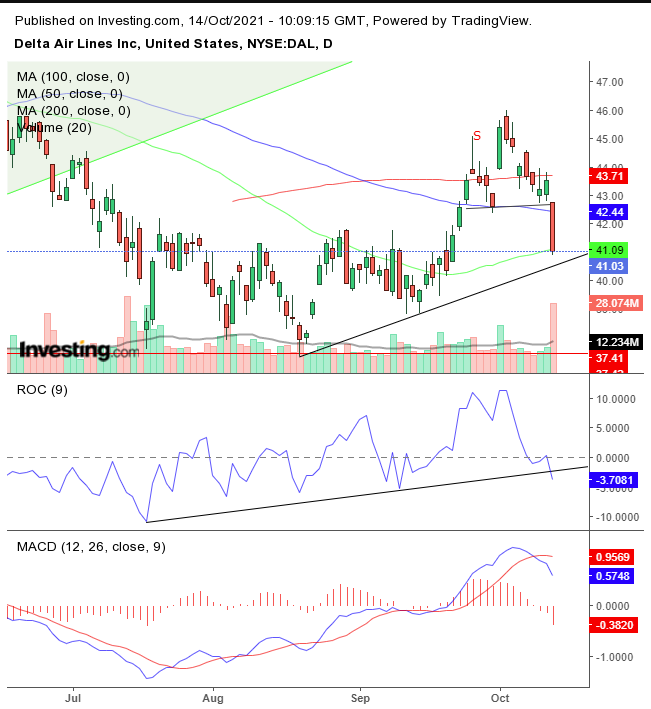Delta Air Lines (NYSE:DAL) suffered its largest daily selloff in a year yesterday and was the worst performer on the S&P 500 Index.
Even though the company beat earnings expectations, it warned that the dramatic surge in jet fuel prices will likely hit next quarter’s profits.
As the first major airline to report earnings, Delta has given investors a preview to the sector. Goldman Sachs suggested as much, downgrading JetBlue Airways (NASDAQ:JBLU) and American Airlines (NASDAQ:AAL), citing the broader sector and placing rising fuel costs as the first of headwinds.
Our study of the price chart suggests potential technical pressure on Delta’s stock.

Delta’s stock may have completed an imperfect, small H&S top, but the volume accompanying yesterday’s selloff, the highest in exactly three months, makes the downside breakout significant.
Note how the major moving averages spread on the chart. The 200-DMA cuts through the price action amid the reversal pattern. The 100-DMA forms the neckline, and the 50-DMA provided support to Wednesday’s downside break.
The RSI suggests the price may cut through its uptrend line, after the RSI did so. The MACD’s short MA crossed below the long MA, triggering a sell signal. Now, let’s take a step back and look at the larger picture.

Now, we can see that our small H&S may be forming the right shoulder of a much larger H&S top, which could span a full year. Again, the main moving averages may help us recognize the pressure points on the price chart. The 50-WMA separates the 10-and-a-half month H&S from the earlier price action.
Note, this week’s trading took the stock below the 50-WMA for the first time since forming the neckline of the H&S top. The 100-DMA supported the head of the pattern and later a resistance to the right shoulder. Finally, the 200-DMA provided the resistance on the earlier uptrend, helping form the head, and later pressured the right shoulder of the reversal formation—meeting up with the bottom of the broken rising channel.
If this larger H&S top will complete, with a decisive downside penetration, the market mechanics could trigger a domino effect that might push prices towards $25 a share.
Trading Strategies
Conservative traders should wait for a resolution of the larger H&S, before risking their capital.
Moderate traders would wait for a rebound off the short-term uptrend line since mid-August, in a return move to retest the neckline of the smaller H&S, and if finding resistance, consider a short.
Aggressive traders could take a long position, counting on dip-buying after yesterday’s historic selloff, then short upon a return to the neckline of the small H&S top. A trade plan is crucial. Here are the basic points:
Trade Sample 1 – Aggressive Long Position
- Entry: $41
- Stop:Loss: $40.50
- Risk: $0.5
- Target: $42.50
- Reward: $1.50
- Risk:Reward Ratio: 1:3
Trade Sample 2 – Aggressive Follow-Up Short Position
- Entry: $42.50
- Stop:Loss: $43
- Risk: $0.5
- Target: $41
- Reward: $1.50
- Risk:Reward Ratio: 1:3
